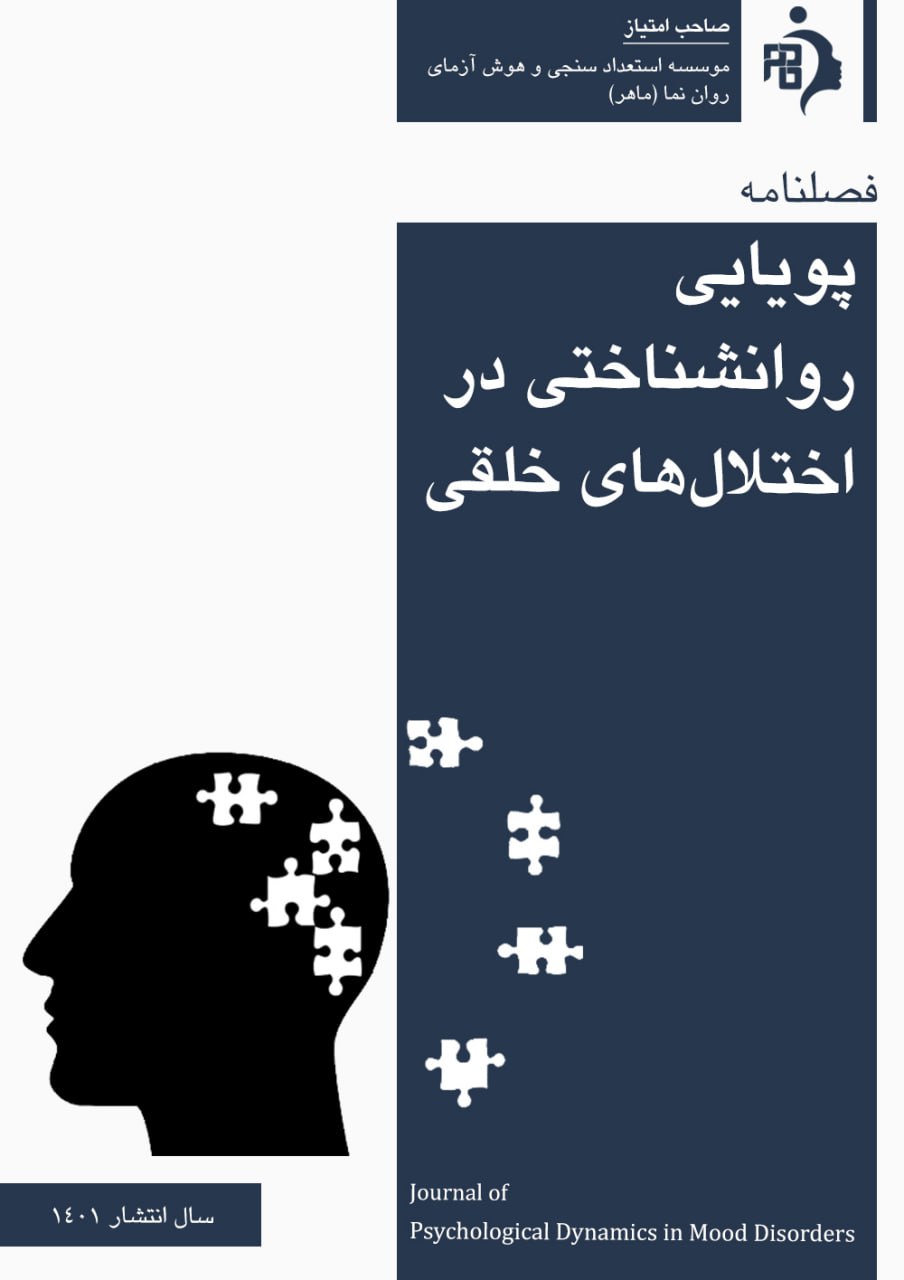Comparing the Effectiveness of Emotional Efficacy Therapy and Exposure and Response Prevention Therapy on Perfectionism in People with Obsessive-Compulsive Disorder
Keywords:
Emotional Efficacy Therapy, Exposure and Response Prevention Therapy, Perfectionism, Obsessive-Compulsive DisorderAbstract
Background and Objective: Obsessive-compulsive disorder is a chronic and debilitating disorder. Therefore, the aim of this study was to comparing the effectiveness of emotional efficacy therapy and exposure and response prevention therapy on perfectionism in people with obsessive-compulsive disorder.
Methods and Materials: The current study was a semi-experimental with a pre-test, post-test and three month follow-up design with a control group. The research statistical population was all people with obsessive-compulsive disorder who referred to counseling centers of Tehran city in 2021 year (about 500 people). The research sample was 51 people who were selected by purposeful sampling method and randomly assigned to three groups. The first and second experimental groups underwent 8 sessions of 60 minutes, respectively by emotional efficacy therapy and exposure and response prevention therapy and the control group remained on the waiting list for therapy. The tools of the current research were the perfectionism inventory (Hill et al., 2004) and the Yale-Brown obsessive-compulsive scale (Goodman et al., 1989). The data of this research were analyzed with the methods of analysis of variance with repeated measures and Bonferroni post hoc test in SPSS-22 software.
Findings: The results showed that both intervention methods of emotional efficacy therapy and exposure and response prevention therapy in compared to the control group led to decrease the perfectionism in people with obsessive-compulsive disorder and the results were maintained in the follow-up stage (P<0.001), but there was no significant difference between the post-test and follow-up stages and between the two intervention methods in reducing their perfectionism (P>0.05).
Conclusion: According to the mentioned results, counselors and therapists can use both methods of emotional efficacy therapy and exposure and response prevention therapy to reduce perfectionism in people with obsessive-compulsive disorder.
Downloads
References
Abbady, A. S. (2023). The effectiveness of emotional schema therapy on improving emotion regulation and reducing neurotic perfectionism among university students. Information Sciences Letters: An International Journal, 12(4), 1853-1862. http://dx.doi.org/10.18576/isl/120410
Acevedo, N., Castle, D. J., Bosanac, P., Groves, C., & Rossell, S. L. (2023). Patient feedback and psychosocial outcomes of deep brain stimulation in people with obsessive–compulsive disorder. Journal of Clinical Neuroscience, 112, 80-85. https://doi.org/10.1016/j.jocn.2023.04.012
Bayrami, M., Hashemi Nosratabad, T., Esmaeilpour, Kh., & Shiri, A. (2021). Effectiveness of emotion efficacy therapy on internet dependency and negative cognitive emotion regulation strategies among students addicted to internet: A quasi-experimental design. Studies in Medical Sciences, 31(12), 927-933. http://umj.umsu.ac.ir/article-1-5279-en.html
Becker, H. C., Beltz, A. M., Himle, J. A., Abelson, J. L., Block, S. R., Taylor, S. F., & Fitzgerald, K. D. (2024). Changes in brain network connections after exposure and response prevention therapy for obsessive-compulsive disorder in adolescents and adults. Biological Psychiatry: Cognitive Neuroscience and Neuroimaging, 9(1), 70-79. https://doi.org/10.1016/j.bpsc.2023.09.009
Behvandi, N., Khayatan, F., & Golparvar, M. (2021). Comparing the effectiveness of compassionate emotion-based integrated therapy with compassion focused therapy on perfectionism and intolerance of uncertainty irrational beliefs in patients with early headache symptoms. Psychological Models and Methods, 12(43), 114-130. https://doi.org/10.30495/jpmm.2021.4727
Boersma, K., Sodermark, M., Hesser, H., Flink, I. D., Gerdle, B., & Linton, S. J. (2019). Efficacy of a transdiagnostic emotion-focused exposure treatment for chronic pain patients with comorbid anxiety and depression: a randomized controlled trial. Journal of Pain, 160(8), 1708-1718. https://doi.org/10.1097/j.pain.0000000000001575
Capel, L. K., Ona, P. Z., Moller, C., & Twohig, M. P. (2023). An open trial of acceptance and commitment therapy with exposure and response prevention in an intensive outpatient setting for adults with OCD. Cognitive and Behavioral Practice, 30(2), 218-228. https://doi.org/10.1016/j.cbpra.2022.01.004
Carlucci, L., Saggino, A., & Balsamo, M. (2021). On the efficacy of the unified protocol for transdiagnostic treatment of emotional disorders: A systematic review and meta-analysis. Clinical Psychology Review, 87, 101999. https://doi.org/10.1016/j.cpr.2021.101999
Chen, H., Xie, M., Ouyang, M., Yuan, F., Yu, J., Song, Sh., & et al. (2024). The impact of illness duration on brain activity in goal-directed and habit-learning systems in obsessive-compulsive disorder progression: A resting-state functional imaging study. Neuroscience, 553, 74-88. https://doi.org/10.1016/j.neuroscience.2024.06.018
Chinnasami, S., Paulraj, R., & Ramasamy, P. (2021). Investigation on the bulk crystal growth, crystalline perfection, refractive index and piezoelectric properties of borate single crystals for piezoelectric and electro-optic applications. Chinese Journal of Physics, 72, 616-627. https://doi.org/10.1016/j.cjph.2021.05.021
Dodd, D. R., Clerkin, E. M., & Smith, A. R. (2022). A randomized test of interpretation bias modification for perfectionism versus guided visualization relaxation among high perfectionistic undergraduate students. Behavior Therapy, 53(5), 843-857. https://doi.org/10.1016/j.beth.2022.01.003
Foa, E. B., Yadin, E., & Lichner, T. K. (2012). Exposure and response (ritual) prevention for obsessive compulsive disorder. 2nd Edition, United Kingdom: Oxford University Press. https://www.amazon.com/Exposure-Response-Prevention-Obsessive-Compulsive-Disorder/dp/0195335287
Goodman, W. K., Price, L. H., Rasmussen, S. A., Mazure, C., Delgado, P., Heninger, G. R., & Charney, D. S. (1989). The Yale–Brown obsessive-compulsive scale II validity. Journal of Archives of General Psychiatry, 46(11), 1012–1016. https://doi.org/10.1001/archpsyc.1989.01810110054008
Hasanpoor, P., Aghayousefi, A., Zamir, M., & Alipoor, A. (2019). The effectiveness of transdiagnostic treatment on experiential avoidance and cognitive emotion regulation in patients with obsessive-compulsive disorder and its comparison with exposure and prevention response therapy. Journal of Clinical Psychology, 11(3), 25-38. https://doi.org/10.22075/jcp.2019.17816.1674
Hashemi Jashni, A., Roushan, R., & Ahadi, H. (2020). Compare the efficacy of exposure therapy and prevention of response and group acceptance and commitment therapy in reducing the severity of symptoms in patients with obsessive-compulsive disorder. Journal of Psychological Science. 19(93), 1141-1148. https://psychologicalscience.ir/browse.php?a_id=706&sid=1&slc_lang=en
Hill, R. W., Huelsman, T. J., Furr, R. M., Kibler, J., Vicente, B. B., & Kennedy, C. (2004). A new measure of perfectionism inventory. Journal of Personality Assessments, 82(1), 80-91. http://dx.doi.org/10.1207/s15327752jpa8201_13
Khalili, M., Mohammadi, M., Sarokhani, F., Ganjifar, Z., & Ternas, Gh. (2022). The effectiveness of emotion therapy on irrational beliefs and perfectionism in female students. Journal of Excellence in Counseling and Psychotherapy, 11(42), 14-24. https://sanad.iau.ir/en/Journal/jci/Article/932053
Liang, T., Ning, Z., & Peng, X. (2024). Big five personality traits on athletes' perfectionism using a person-centered approach. Asian Journal of Sport and Exercise Psychology, 4(2), 60-64. https://doi.org/10.1016/j.ajsep.2024.06.001
Malehmir, B., Mikaeeli, N., & Narimani, M. (2021). Comparison of family functioning and thought-action fusion in patients with obsessive-compulsive disorder, bipolar disorder and normal people. Medical Journal of Mashhad University of Medical Sciences, 64(4), 3854-3867. https://doi.org/10.22038/mjms.2021.19859
McKay, M., & West, A. (2016). Emotion efficacy therapy: A brief, exposure-based treatment for emotion regulation integrating ACT and DBT. 1st Edition, America: Context Press/ New Harbinger Publications. https://www.amazon.com/Emotion-Efficacy-Therapy-Exposure-Based-Integrating/dp/1626254036
Nanthakumar, S., Albertella, L., Do Rosario, M. C., Brierley, M. E. E., & Fontenelle, L. F. (202). Clinical features of obsessive-compulsive disorder among individuals who experience health-related obsessive-compulsive symptoms. Journal of Affective Disorders, 369, 861-867. https://doi.org/10.1016/j.jad.2024.10.014
Petersen, J., Ona, P. Z., Blythe, M., Moller, C. M., & Twohig, M. (2022). Intensive outpatient acceptance and commitment therapy with exposure and response prevention for adolescents. Journal of Contextual Behavioral Science, 23, 75-84. https://doi.org/10.1016/j.jcbs.2021.12.004
Rahmani Javanmard, S., Bassak Nejad, S., Arshadi, N., & Selby, E. (2022). The effect of mindful self-compassion therapy on the interpersonal needs among patient with obsessive-compulsive disorder with suicidal thoughts. Knowledge & Research in Applied Psychology, 23(2), 90-105. https://doi.org/10.30486/jsrp.2020.1913930.2697
Sarichloo, M. E., Taremian, F., Haji SeyedJavadi, S. A., & Dolatshahi, B. (2019). Effectiveness of exposure/response prevention plus eye movement desensitization and reprocessing in improve cognitive components in patients with obsessive-compulsive disorder and life stressful experiences: A randomized controlled trial. Iranian Journal of Psychiatric Nursing, 7(5), 79-89. https://ijpn.ir/article-1-1438-en.html
Shagirbasha, Sh., Iqbal, J., & Madhan, K. (2023). Does social perfectionism foster electronic cheating behavior among budding hospitality managers? A moderated mediation analysis. Journal of Hospitality and Tourism Management, 56, 297-311. https://doi.org/10.1016/j.jhtm.2023.06.023
Thompson, B. L., Twohig, M. P., & Luoma, J. B. (2021). Psychological flexibility as shared process of change in acceptance and commitment therapy and exposure and response prevention for obsessive-compulsive disorder: A single case design study. Behavior Therapy, 52(2), 286-297. https://doi.org/10.1016/j.beth.2020.04.011
Twohig, M. P., Abramowitz, J. S., Smith, B. M., Fabricant, L. E., Jacoby, R. J., Morrison, K. L., & et al. (2018). Adding acceptance and commitment therapy to exposure and response prevention for obsessive-compulsive disorder: A randomized controlled trial. Behaviour Research and Therapy, 108, 1-9. https://doi.org/10.1016/j.brat.2018.06.005
Vanzhula, I. A., Kinkel-Ram, S. S., & Levinson, C. A. (2021). Perfectionism and difficulty controlling thoughts bridge eating disorder and obsessive-compulsive disorder symptoms: A network analysis. Journal of Affective Disorders, 283, 302-309. https://doi.org/10.1016/j.jad.2021.01.083
Zisler, E. M., Meule, A., Koch, S., Schennach, R., & Voderholzer, U. (2024). Duration of daily life activities in persons with and without obsessive–compulsive disorder. Journal of Psychiatric Research, 173, 6-13. https://doi.org/10.1016/j.jpsychires.2024.02.052
Zivari Azhar, M. H., Khanmohammadi, A., Abasi Asfajir, A. A., & Hoseinzadeh, B. (2024). The structural relationship of perfectionism on academic achievement anxiety with the mediating role of spiritual intelligence and happiness. Journal of Psychological Science, 23(133), 79-93. http://dx.doi.org/10.52547/JPS.23.133.79



























